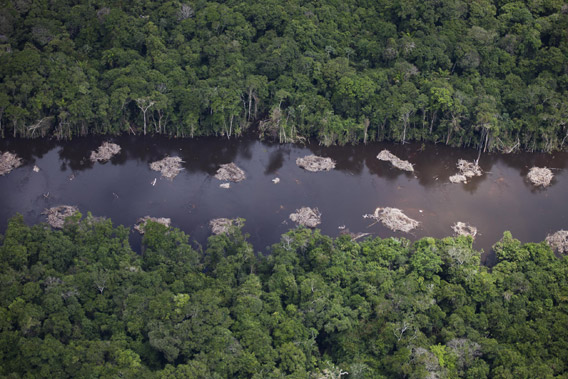150 indigenous protesters have once again occupied the Belo Monte dam site in an effort to block the controversial project, reports Amazon Watch, an NGO that is helping lead the fight against the dam.
Amazon watch says that members of the Parakanã and Juruna indigenous communities blocked a key access road, shutting down construction activities for the day. It was the eighth occupation since 2012.
This demonstration aimed to push the government to respect the tribes’ rights as well as earlier commitments to remove settlers from indigenous lands.
“We are telling the federal government and Norte Energia that we are tired of waiting for you to resolve the fact that our lands have been invaded illegally by farmers, land grabbers, miners, loggers, and colonizers who for many years have destroyed our traditional territory, preventing us from hunting, planting, or caring for our children, while threatening our people,” stated a declation issued by the protesters. “The government does not care about our territory, it does not care about indigenous people, it does not care about our suffering; it only cares about Belo Monte.”
“This protest shows yet again the indignation of indigenous populations that have had their rights systematically disrespected,” said Antonia Melo of the Xingu Alive Forever Movement. “Two years passed with no resolution nor implementation for protection of their lands as was promised. The government is leaving them in an extremely vulnerable situation while making it clear that they do not care about traditional populations.”

Construction of the Belo Monte Dam project, near Altamira. Photo by © Greenpeace/Daniel Beltra.
Belo Monte has been plagued by protests since it got the offical go-ahead in June 2011. The project will divert nearly 80 percent of the flow of the Xingu river, one of the Amazon’s mightiest tributaries, while flooding thousands of hectares of land, displacing more than 15,000 people. Analysts say Belo Monte will likely require additional upstream dams to be commercially viable potentially amplifying the project’s social and environmental impact.
Belo Monte and other dams on the Xingu represent just a small fraction of the hydropower projects being developed by Brazil in the Amazon Basin. According to an analysis published in 2012, 231 dams are currently planned in the Brazilian Amazon alone. Another 15 are slated for Peru and Bolivia.
Ecologists say there are myriad problems with large dams in tropical ecosystems, especially when built on the scale envisioned in the Amazon. Large dams interfere with the hydrological cycle and nutrient flows through an ecosystem, while restricting or blocking access to breeding and feeding grounds for migratory fish species. Meanwhile areas inundated with water can generate substantial greenhouse gas emissions. Design flaws in some tropical dams, which draw methane from the base of their reservoirs, can exacerbate climate impacts. Finally flooding in the reservoir area can displace communities traditionally dependent on rivers, while creating hardship downstream from degraded fisheries.

May 2013 protest at one of the main construction sites of the Belo Monte Dam complex in the municipality of Victoria de Xingu. Photos ©Ruy Sposati/CIMI
Related articles